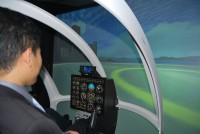Some of the most significant advances in air safety are about to be achieved without anyone leaving the ground.
Australia’s leading Aviation Simulation Laboratory was opened on 22 March by Victorian Aviation Industry Minister Mr Gordon Rich-Phillips at Swinburne University of Technology’s Hawthorn Campus.
The new laboratory is the only research facility in Australia to be equipped with simulators capable of replicating flight in both aeroplanes and helicopters.
Researchers will use a variety of methods to monitor both experienced and trainee pilots using the facility in a range of projects which will examine the impact of issues such as fatigue, poor visibility and pilot inexperience on flight safety, the Deputy Vice-Chancellor (Research) Professor Matthew Bailes said.
“Australians rely on aeroplanes and helicopters to connect us to each other and the world. Their navigation, operation and simulation are complex ICT/engineering problems. So it is appropriate that a University of Technology like Swinburne should establish itself as a regional leader in aviation research,” Professor Bailes said.
The FlyIt Professional Helicopter Simulator is the only one of its kind in Australasia and is capable of simulating six types of helicopter, including the Bell 206 Jet Ranger light turbine helicopter.
“Helicopters are used extensively in civil aviation, from fighting fires to shuttling workers to oil rigs; but research into key factors to improve the performance and safety of helicopter pilots is quite minimal,” Professor Bailes said.
The laboratory is also equipped with Victoria’s only Redbird flight simulator, capable of simulating flight in a single-engine Cessna 172 and a twin-engine Beechcraft Baron. A full-sized Cessna is also housed at the Hawthorn laboratory, providing hands-on opportunities for maintenance training.
“This facility will enable researchers to study some of the key stressors and challenges faced by pilots – ensuring this Laboratory will make a valuable contribution to improving safety, with an impact both in Australia and beyond,” said Stephen Fankhauser, Swinburne’s Aviation Discipline Leader.
“In the future, Swinburne hopes to further expand the scope and scale of aviation research, working closely with our industry partners,” added Mr Fankhauser.
The opening of the facility coincides with the 20th Anniversary of Swinburne’s Bachelor of Aviation degree, which took its first intake of students in 1992.


